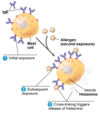The Immune System Flashcards
(103 cards)
What is a pathogen?
Bacteria, fungi, virus, etc…
How does innate immunity work? Is it fast or slow?
Recognizes traits that are shared by a broad range of pathogens using a small set of receptors.
Rapid response
Do all animals have innate immunity?
YES
What are the two types of defenses that the innate immunity provides humans with? What do these defenses consist of?
Barrier defenses - skin, mucus membranes, secretions
Internal defenses - Phagocytic cells, NK cells, antimicrobial proteins, inflammatory response
How does adaptive immunity work? Is it fast or slow?
The recognition of traits specific to particular pathogens using a vast array of many receptors.
Slower response
Do all animals have adaptive immunity?
NO, just vertebrates.
What are the two responses of the adaptive immunity and what do they consist of?
Humoral response - antibodies defend against infection IN BODY FLUIDS
Cell-mediated response - cytotoxic cells defend against infection IN BODY CELLS
Describe the innate immunity of invertebrates, for example an insect, separate into barrier and internal defenses.
Barrier - exoskeleton, digestive system has low pH and lysozyme (break down cells walls of bacteria)
Internal - Hemocytes in hemolymph carry out phagocytosis and secrete AMP (antimicrobial peptides), bacteria and fungi are recognized due to their unique molecules on cell walls and the immune response varies based on the class of pathogen encountered.
Understand this picture that covers phagocytosis
DO IT

Look at this graph of fruit fly infection and understand how different AMPs help to defend against DIFFERENT pathogens in the innate immunity.
Mutants produce no AMPs.
Drosomycin and defensin are AMPs

Have a basic understanding of antiviral defense in insects based on this picture. The steps are listed in the book.
:)

For vertebrates, describe the different barrier defenses that are present in the innate immunity. What is the purpose of mucus?
Barrier defenses:
Skin
Mucus membranes of digestive, respiratory, urinary, and reproductive tracts. Mucus traps microbes and other particles
Saliva, mucus, and tears contain lysozyme that destroy susceptible bacteria
Low pH of skin and digestive system prevents microbe growth
Describe TLRS of the internal defense of innate immunity that are present in phagocytic cells, what are the 4 types of phagocytes found in mammals?
Phagocytes:
Phagocytes have TLRs - toll-like receptors, bind to lipopolysaccharide (endotoxin), flagellin, and other pathogenic proteins.
Mammalian Phagocytes:
Neutrophils - most abundant
Macrophages - Large, found throughout the body and are part of lymphatic system
Eosinophils - release destructive enzymes to combat MULTICELLULAR INVADERS (like worms)
Dendritic cells - stimulate development of adaptive immunity
What do dendritic cells have that distinguish them?
Tree-like branches
What is the difference between a monocyte and a macrophage?
Monocytes reside in the blood stream, but when they migrate to tissues they become macrophages OR dendritic cells.
What is the other cell type that are a part of the internal defense of the innate immunity? What is their function?
NK cells - help recognize and eliminate certain diseased cells,.
What is an example of a diseased cell that NK cells might eliminate?
Cancerous or infected cells.
How does an NK cell know when a cell is cancerous or diseased?
Normally all nucleated cells in the body have MHC (major histocompatibility complex) class I proteins on their surface.
Cancerous of infected cells no longer express this protein, so NK cells know they need to be eliminated.
What is an example of a cell that doesn’t have a nuclei, and, therefore doesn’t express MHC class I?
RBCs.
Where is the lymphatic system do both macrophages and lymphocytes reside to engulf pathogens?
The spleen and lymph nodes

Describe the antimicrobial peptides and proteins portion of the internal defenses of the innate immunity in vertebrates. What are interferons and the complements system?
Pathogens that are recognized in mammals stimulate the release of peptides that attack microbes. Some of these are similar to the AMPs that are released in insects.
Interferons - proteins that provide innate defense against viruses and help to activate macrophages. These are released from the infected host cells to neighboring cells to tell them to INTERFERE.
Complement system - made up of about 30 proteins, causes lysis of invading cells and to help trigger inflammation. Produced by liver and circulate in an inactive state.
Where are NK cells derived from?
LYMPHOID STEM CELLS
What are the four cardinal signs of the inflammatory response that is part of the internal defense of innate immunity?
Redness (rubor, erythema) - increased blood flow
Heat (calor) - increased blood flow
Swelling (tumor, edema) - leaky blood vessels
Pain (dolor)
What is the function of MAST cells in the inflammatory response? What is the function of histamines?
Release histamines at sites of tissue damage
Histamines - cause blood vessels to dilate and become more permeable.





















